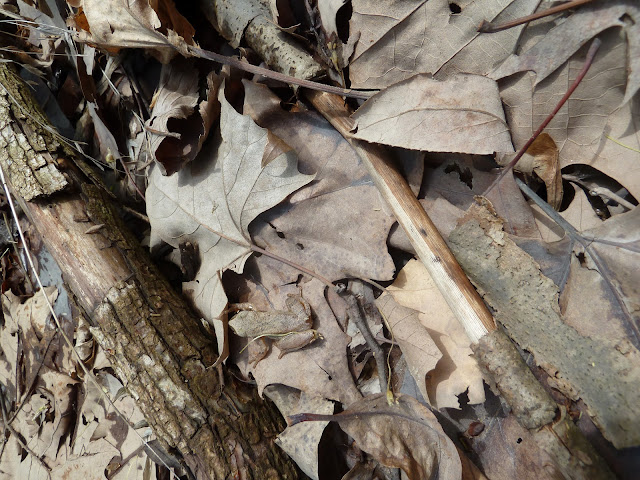 | |||
| Find the peeper - click to enlarge - answer below | |
Driving by our pond we stopped to hear the first spring peepers. Barb could hear them faintly but I couldn't. Later way out in the field we found the source in a water filled tire rut. As I approached it they were almost deafening as heard here. As I bent down to find one they all stopped singing.
"The species is one of the first anurans to begin breeding after winter hibernation. The breeding period lasts from March - June, when 800 - 1000 eggs per female are laid in shallow ponds. The eggs hatch within 6 to 12 days, and tadpoles transform to adults during July (range 45 - 90 days)." Animal Diversity Web
 |
| Dragonfly nymph attacking peeper egg with tadpole inside - LB |
This time of year is when male spring peepers (Pseudacris crucifer) audition for their ladies. They have emerged from hibernation and the three year olds are now ready for mating. (Over 21? See the x-rated details here.)
"The spring peeper produces glucose, or sugar, and "freezes" itself for the winter. In winter, peepers' bodies freeze--but their cells don't rupture because of the concentrated sugars in them. These sugars act as a kind of natural anti-freeze.
Like many of the chorus frogs, the spring peeper is often heard, but not seen. It gets its name from its call, which consists of a single clear note or peep, occurring once a second. Only the males sing, calling from shrubs and trees standing in or overhanging water.
The faster and louder a male sings, the more likely he is to attract a mate. A male peeper may also give a lower-pitched trilled whistle, usually when another male has moved too close to its calling site. During the daytime, peepers often call during light rains or in cloudy weather." Maryland DNR
 |
| X marks the frog - REK |
Peepers are hard see, let alone to photograph, as they are watching for anything moving above them. At less than 1.5" almost everything is higher. They have great camouflage, with a faint "X" on the back as their distinguishing mark, the reason for the name P. crucifer (crucifer = “cross-bearer”). Because of the cacophonous chorus, it is hard to localize an individual frog.
A few years ago I chose a pond with a six foot high dam so I could approach the water from below unseen. The chorus was in full voice by 4:45pm while the low lying sun was still reaching the pond surface. I crawled up the side on my belly like my Uncle Sam taught me, discovering in the process that my belly wasn't the same one I had used in 1967.
I reached the top and peered over and saw....nothing! There was the water, dead leaves and floating sticks with even a few mushrooms, but no frogs. The cacophony continued unabated, scattered voices from all around the pond edges. Finally I made out a tiny bump that seemed to vibrate on a log to my left.
 Crawling six feet to the left and then peeking over the edge I was face to face with a singing peeper. He watched me closely as I ever so slowly brought out my pocket camera. I waited several minutes with my arms outstretched until he again joined the chorus. The next 10 minutes I continued to film it, pausing when it became suspicious and stopped singing. Mission accomplished with this video!
Crawling six feet to the left and then peeking over the edge I was face to face with a singing peeper. He watched me closely as I ever so slowly brought out my pocket camera. I waited several minutes with my arms outstretched until he again joined the chorus. The next 10 minutes I continued to film it, pausing when it became suspicious and stopped singing. Mission accomplished with this video!
A final confession. I broke the rule of "Take nothing but pictures leave nothing but footprints, kill nothing but time." When I got home I discovered I had taken a number of ticks from the pond dam. You can guess the killing part.
 |
| Tadpole emerges left upper, intact egg with tadpole to the right - Linda Bower |
Our Linda Bower produced this incredible video of spring peeper tadpoles emerging from their eggs, the end product of a mighty spring peeper choir. You can find this and more on her Nature in Motion Youtube Channel.
==========================
Did you find the Peeper? Here it is.
 |
| Click to enlarge |